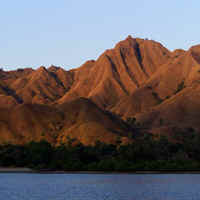|
Homepage
 |
Komodo
National Park is located in the center of the Indonesian
archipelago, between the islands of Sumbawa and Flores. Established
in 1980, initially the main purpose of the Park was to conserve
the unique Komodo dragon (Varanus komodoensis) and
its habitat. However, over the years, the goals for the Park
have expanded to protecting its entire biodiversity, both
terrestrial and marine. In 1986, the Park was declared a World
Heritage Site and a Man and Biosphere Reserve by
UNESCO, both indications of the Park's biological importance.
Komodo National Park includes
three major islands: Komodo, Rinca and Padar, as well as numerous
smaller islands creating a total surface area (marine and
land) of 1817km (proposed extensions would bring the total
surface area up to 2,321km2). As well as being
home to the Komodo dragon, the Park provides refuge for many
other notable terrestrial species such as the orange-footed
scrub fowl, an endemic rat, and the Timor deer. Moreover,
the Park includes one of the richest marine environments including
coral reefs, mangroves, seagrass beds, seamounts, and semi-enclosed
bays. These habitats harbor more than 1,000 species of fish,
some 260 species of reef-building coral, and 70 species of
sponges. Dugong, sharks, manta rays, at least 14 species of
whales, dolphins, and sea turtles also make Komodo National
Park their home. |
Threats to terrestrial biodiversity
include the increasing pressure on forest cover and water resources
as the local human population has increased 800% over the past 60
years. In addition, the Timor deer population, the preferred prey
source for the endangered Komodo dragon, is still being poached. Destructive
fishing practices such as dynamite-, cyanide, and compressor fishing
severely threaten the Park's marine resources by destroying both
the habitat (coral reefs) and the resource itself (fish and invertebrate
stocks). The present situation in the Park is characterized by reduced
but continuing destructive fishing practices primarily by immigrant
fishers, and high pressure on demersal stocks like lobsters, shellfish,
groupers and napoleon wrasse. Pollution inputs, ranging from raw
sewage to chemicals, are increasing and may pose a major threat
in the future.
Today, the PKA Balai Taman Nasional
Komodo and PT. Putri Naga Komodo are working together
to protect the Park's vast resources. Our goals are to protect the
Park's biodiversity (both marine and terrestrial) and the breeding
stocks of commercial fishes for replenishment of surrounding fishing
grounds. The main challenge is to reduce both threats to the resources
and conflicts between incompatible activities. Both parties have
a long term commitment to protecting the marine biodiversity of
Komodo National Park.
|


